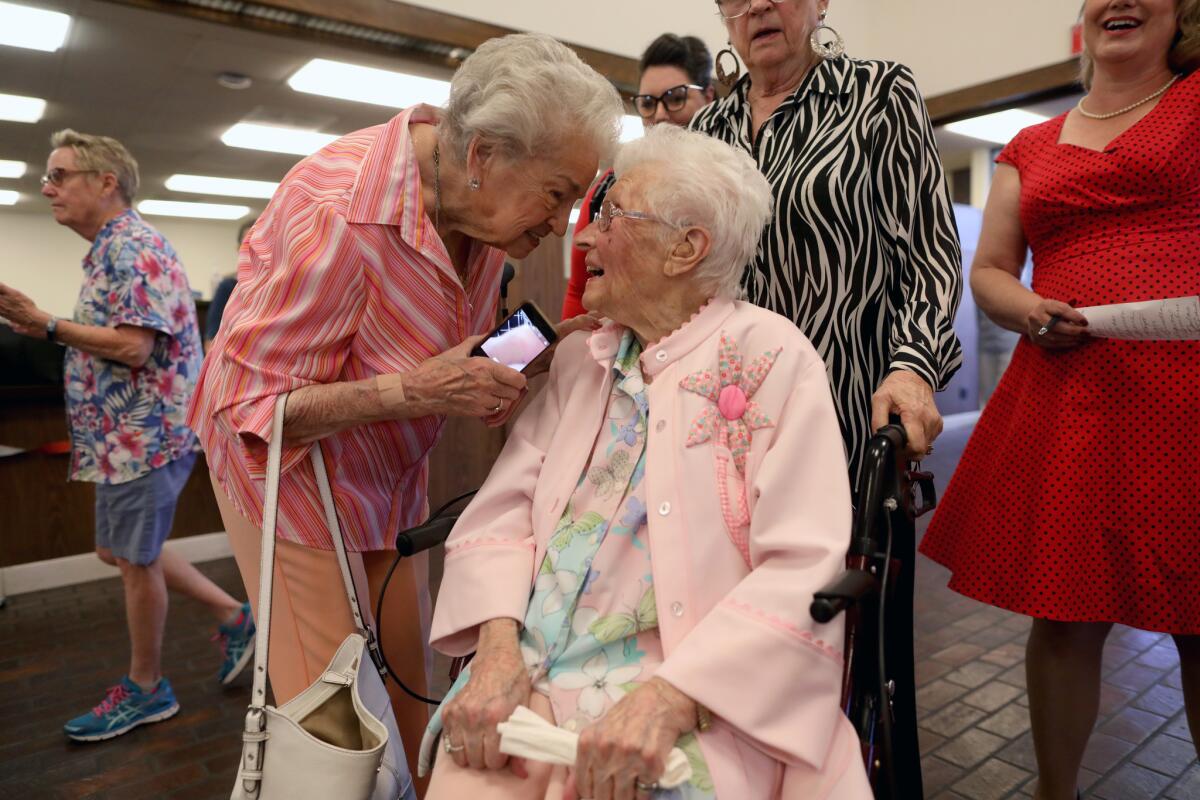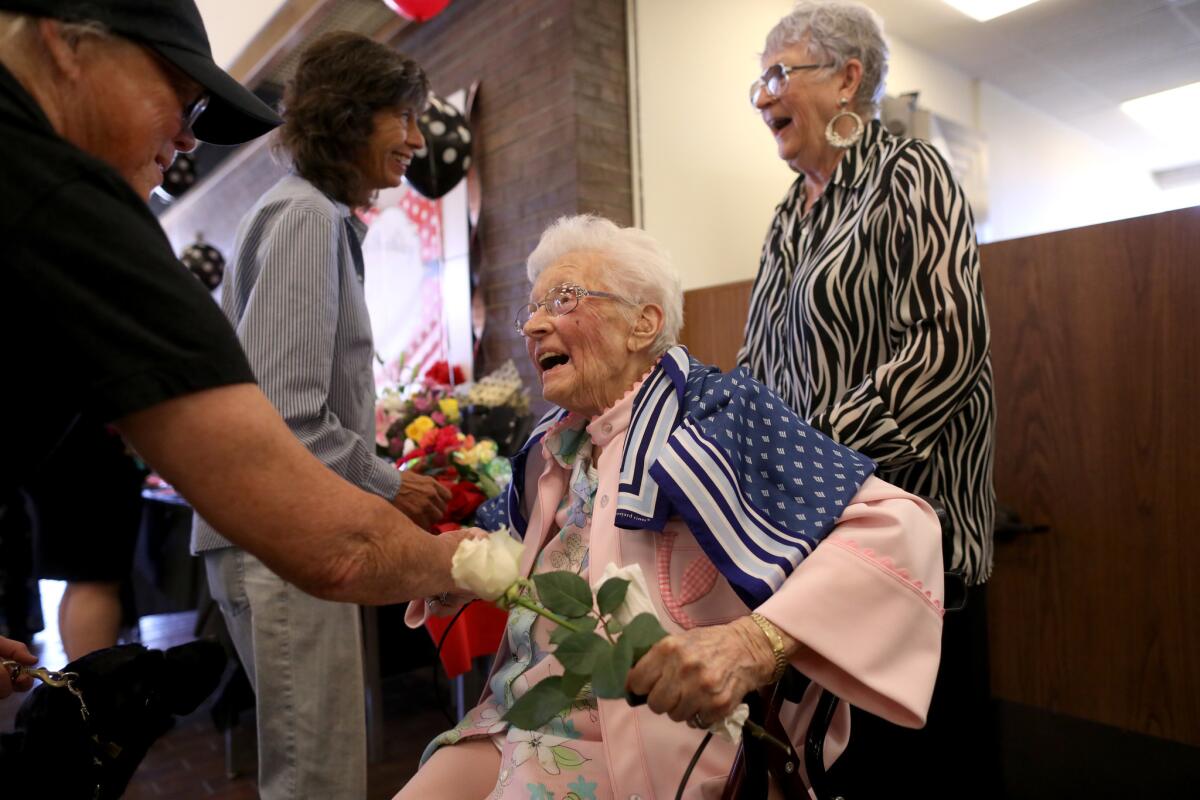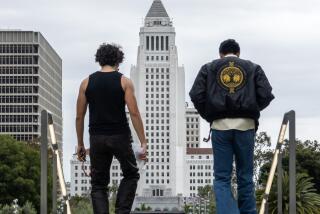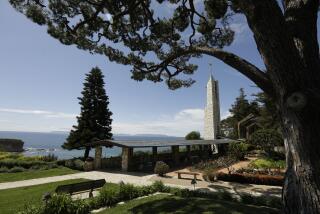Ridgecrest is isolated. But massive earthquakes show it’s not alone

- Share via
Reporting from Ridgecrest, Calif. — Opal Goode turned 112 in June, about a month before the big earthquakes that still have this town rumbling.
The local Bank of America, where she worked for 20 years (more than 50 years ago), threw a party, and everyone was invited. It would have been the event of the summer if it hadn’t been upstaged by the 6.4 quake on July 4 and the 7.1 the next day.
Members of the high school band played “Anchors Aweigh” — the Naval Air Weapons Station in nearby China Lake employs much of the town. Volunteers with Paws to Serve brought the puppies they’re raising to be guide dogs. And John “Skip” Gorman, a metal artist who shares a “potpourri of thoughts and observations” on his Ridgecrest blog, read a poem about Opal that won him a laugh and a kiss from the guest of honor.
On the couch nearest the table of cupcakes, 9-year-old Loretta Banks sat with her sisters Lucy, 7, and Lavender, 2. Loretta wondered aloud what she would remember when she was an old lady. It would probably be her sisters and desert wildflowers, she said.
That conversation has stuck with her mother, Kaley Banks, who at 35 has lived in Ridgecrest her whole life and wants to see more of the world.
Ridgecrest is isolated.

The road east from Bakersfield leads past nearly deserted mining towns and red rock cliffs formed by faults beneath the earth. The city of 29,000 is at least 100 miles in every direction from an urban center or natural body of water.
“I suppose there are more temperate places,” 90-year-old Barbara Butler said during the birthday celebration. “But Ridgecrest is such a fun town. We’re a long way away from things, so we rely on each other. A group of us ladies have breakfast at Kristy’s restaurant every Tuesday.”
When the earthquakes hit, that self-reliance was needed.
“Right away, people were posting on Facebook: ‘What do you need? I have a truck. I have water. I have lights. Call me,’” Kaley said.
On Friday, Kaley’s neighbors wanted to get out of town amid all the shaking, but their five children were screaming, making it hard to pack.
Kaley and her husband helped out by watching over them for a bit — temporarily bringing the total under their roof to eight kids and seven rescue dogs.
After the neighbors left, the Bankses packed for one night away while their three little girls sat on the big living room couch.
“They were crying, just sobbing and holding on to each other. All three kept saying, ‘It’s going to be OK,’ and they calmed each other down,” Kaley said.
When she asked Loretta after things had settled down what she would remember when she was old, her daughter said, “7.1.”
Opal’s 81-year old daughter, Cheryl Bernhardi, once asked her mother what she remembers most.
“It’s the funniest thing,” Opal told her. “But I dream about being able to sweep my front porch one more time.”

Born in Oklahoma, Opal moved to Texas with her family by covered wagon when she was 3 — then back again three years later in the same wagon pulled by the same mules. They had a car by the time they came to California.
During the Great Depression, Opal’s “perfect” skin landed her a job at a cosmetic counter in Bakersfield. There were times when her parents couldn’t find work, and the family survived on her wages of $16 a week. After that she remained thrifty. She still saves bits of paper.
Opal and her husband, Henry, moved to Ridgecrest in 1945 because he wanted to work on jets. She sewed and canned, and rose from bank teller to bank manager. Her favorite saying was “Hard work never killed anybody, so long as you eat properly and get plenty of rest.”
Back then, she was good friends with Jo Williams, who worked at the dress shop. Guests at the birthday party recalled both women as uncommonly beautiful and vivacious. At 104, Jo still drives. She picks up Opal every week to go to breakfast.
No one lives more than 100 years without losses.

Opal said she’s buried too many people, most of all Henry. Her skin is thin like tissue and her legs too weak for walking. When her daughter visited her at the High Desert Haven assisted living facility amid the thousands of aftershocks, Opal patted her hand and said, “Rough couple of days, huh, honey?”
Cheryl told her things at her Ridgecrest house were a mess, but little was broken.
“That’s wonderful!” whispered Opal. “You can just carry on.”
About every time their phone rings, Cheryl and her husband, Bruce, take a deep breath, knowing it could be the call telling them Opal is gone.
“But every day is special because she’s here one day longer,” Cheryl says.
Skip Gorman said that’s how people in Ridgecrest are feeling about everything these days.
“We all watched Dr. Lucy look square in the camera, shrug her shoulders and say there could be an even bigger one,” he said, referring to Caltech seismologist Lucy Jones.
“So for now we’ll just leave the pictures hanging crooked, take a sip of the expensive stuff, swell with gratitude this one wasn’t worse and get on with things.”
More to Read
Sign up for Essential California
The most important California stories and recommendations in your inbox every morning.
You may occasionally receive promotional content from the Los Angeles Times.










